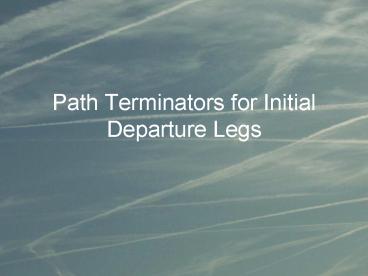Path Terminators for Initial Departure Legs - PowerPoint PPT Presentation
1 / 19
Title:
Path Terminators for Initial Departure Legs
Description:
( VA may be used by data-house when coding parallel runway operations) DLH experience shows that CA better than FA on initial SID leg. ... – PowerPoint PPT presentation
Number of Views:199
Avg rating:3.0/5.0
Title: Path Terminators for Initial Departure Legs
1
Path Terminators for Initial Departure Legs
2
Background
- TGL 10 requires CF, DF, FA, IF and TF
functionality in P-RNAV systems. - EUROCONTROL Guidance Material recommends the use
of FA, CF, DF and TF path terminators when coding
SIDs and proposes FA with CF or DF to start the
SID. (VA may be used by data-house when coding
parallel runway operations) - DLH experience shows that CA better than FA on
initial SID leg. - ICAO introducing path terminator requirements in
PANS-OPS including VA and VI. - Evidence that designers already confused by the
subset defined in existing guidance material.
3
Trial Setup
- Trials of different path terminator combinations
conducted using Smiths PC-Sim - PC-based simulator.
- Same processor and architecture as FMS in B737
6/7/8/900, BBJ etc. - Same performance as airborne FMS.
- Operational packed navigation database.
- Different departure combinations coded and flown
under different wind conditions. - No manual input during departure other than gear
and flap retraction hence aircraft climbs on
heading until autopilot engaged at 500ft agl.
4
PC Sim is manufactured by
5
PC Sim Process
- Define procedure to be flown.
- Code procedure for navigation database (Full
ARINC 424 coding required). - Generate operational database (Available only
through authorised data packer). - Load database.
- Set met conditions.
- Fly procedure.
- Output recorded data.
6
Simulation Results - 1
VA (183º 3000ft), CF (270º EHM20) Wind 47kts
223º Wind 35kts 244º Note after reaching
3000ft logic seems to change flying course to
turn initiation point
7
Simulation Results - 1
Extreme case of a straight departure 15 turn
at DER
No wind
30kts cross-wind
8
Simulation Results - 2
Showing difference between CA and VA ground
track After 500ft agl, when AP engages, CA
recovers to 184 track while VA remains on 184
heading until 2000ft agl.
9
Simulation Results - 3
Early turning departure 46 turn 2.6NM from DER
No Wind
30kts Cross-wind
10
Simulation Results - 4
CF 183º to 10NM CF 270º to EHM20 IRS error of 1
lat and 1 long No wind No radio updating before
3000ft (GNSS, DME/DME and VOR/DME)
11
Simulation Results - 5
FA(1842000ft)/DF CA(1842000ft)/DF
12
Results Analysis
- Simulation did not address the initial climb to
500ft when the aircraft always maintained runway
heading. - VA, VI and CA generate very similar ground tracks
in still air. - VI seems to provide better track-keeping than VA,
particularly in high cross-winds. - Max displacement between VA and VI ground tracks
in simulation 450m. - May be an avionics specific feature.
- CA controls drift in cross-wind conditions and is
not affected by IRS errors. - CA/CF, VA/CF and VI/CF are all effective
solutions for early turns in departure procedures
where IRS updating may be used by some aircraft.
13
Conclusion/1
- Procedure designer needs to be able to provide
clear and unambiguous description of RNAV
procedure (includes the ground track). - Path terminator useful short-hand for required
leg-following function - Fly heading/track
- Turn at altitude/waypoint/not before...
- Procedure designer should not be expected to
become ARINC 424 coding expert taking account of
all different system peculiarities. - PANS-OPS provides an option for
datahouses/avionics manufacturers - In certain cases, alternative path terminators
may be used to enable specific RNAV systems to
better follow the intended track such actions
should be approved by the associated State
Regulator and are within the purview of the data
coder and the avionics manufacturer.
14
Conclusion/2
- Designer should work with the smallest possible
sub-set of path terminators - Headings use VA or VM for departures use VA
- Tracks use FA, CA, CF, DF, FM, RF or TF for
departures use DF or CF - Turn at altitude but not before(TAABNB) CA/CF
or VA/CF CA/CA or VA/CA - Turn at altitude (CA or VA from the runway, FA
from a waypoint, CA from a TAABNB) - Industry can get approval to alter coding where
this can be shown to be a better solution for a
particular aircraft system.
15
Coding the First 500ft
- Simulation did not address the initial climb to
500ft when the aircraft always maintained runway
heading. - RNAV has little influence on aircraft
track-keeping during take-off phase - LNAV systems engage at different heights agl.
- Autopilots generally do not engage before 500ft
agl. - Manual flight may be considered the norm, at
present, up to at least 500ft agl. - Should procedure definition, in path terminator
context, start from 500ftagl? Probably not!
16
Coding the Initial Departure Legs
- Initial SID coding should be compatible with all
approved aircraft - VA(xxxxft) followed by CA, CF or DF can be flown
by all P-RNAV aircraft - The other get out option is to describe the
initial legs conventionally and start the
official RNAV procedure once the aircraft is in
adequate coverage and the design can meet the
criteria (min distance between waypoints etc.) It
will still be coded by the datahouses.
17
Initial Legs Conventional/1
Rwy hdg to 2.5 D HEL, turn right to intercept
R254 HEL
FD (222º, 710ft, 2.5D) VI (285º) CF (254º) HK619
No Wind
FD (222º, 710ft, 2.5D) CI (285º) CF (254º) HK619
18
Initial Legs Conventional/2
Rwy hdg to 2.5 D HEL, turn right to intercept
R254 HEL
FD (222º, 710ft, 2.5D) VI (285º) CF (254º) HK619
30kt X-wind 30kt Headwind
FD (222º, 710ft, 2.5D) CI (285º) CF (254º) HK619
19
QUESTIONS?































